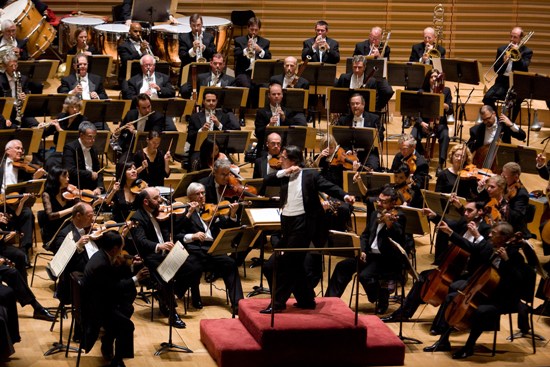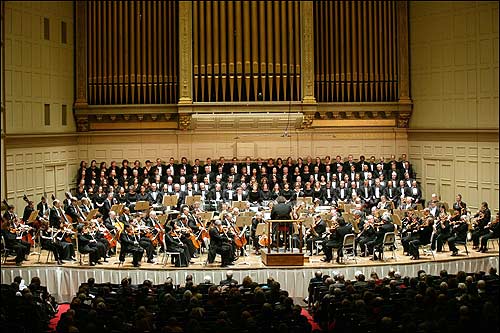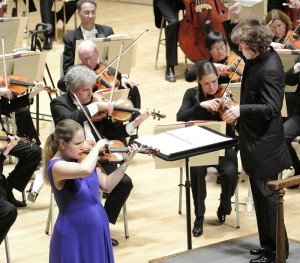Classical Music Commentary: Just How Perilous Is the Life of The Boston Symphony Orchestra?
The overall prognosis for the Boston Symphony Orchestra is good. While there remains room for growth and improvement both artistically and financially, the orchestra has the advantage of a solid musical reputation and a strong core of patrons who support its mission.
By Jonathan Blumhofer
Earlier this year, I reviewed Robert J. Flanagan’s The Perilous Life of Symphony Orchestras, a tome that charts the economic challenges facing American symphony orchestras over the last several decades and concludes with grim prophecies for the future.
As I noted at the end of my review, Boston is a city that rivals a select few (New York, London, Berlin) in possessing a large number of significant orchestral ensembles: in addition to the Boston Symphony (BSO), there is the Boston Philharmonic, the Boston Modern Orchestra Project, the Handel and Haydn Society, and Boston Baroque—not to mention groups like A Far Cry and the Discovery Ensemble. So how are these orchestras faring in the current economic malaise? To get a sense of the health of orchestras in and around Boston, I’ve taken a look at annual reports from three ensembles that represent something of a cross-section of the region’s musical pulse—the BSO, the Handel and Haydn Society, and the Boston Modern Orchestra Project—and asked some questions of administrators and musicians, to see how things are going, locally.
For this first installment, I’m taking a look at the Boston Symphony Orchestra.
The BSO has, in recent years especially, stood as a beacon of relative financial stability, even as questions about artistic leadership swirled amid James Levine’s premature resignation as music director last year. Still, several of the troublesome issues Mr. Flanagan discusses in his book are present in the BSO’s most recent annual report (for FY 2011).
To be sure, there are positive signs: an endowment of nearly $400 million (on the upswing after losing nearly 20% of its value in the 2008–09 market crash); strong giving on the part of BSO patrons (making up 28% of the orchestra’s revenue); and significant concert attendance (over 2.3 million, including concerts at Symphony Hall, Tanglewood, the Pops, and other BSO-produced events). These are numbers that any orchestra—big or small—would envy. That the orchestra posted a small loss on the 2010–11 season ($353,000 on a total budget of just over $80 million) is unfortunate, though not entirely surprising, considering Mr. Levine’s numerous cancellations, severe winter weather, and the cancellation of the BSO’s last Tanglewood concert (courtesy of Tropical Storm Irene).
In examining a breakdown of the BSO’s expenses and income, we see trouble spots identified in Mr. Flanagan’s book, as well as some acknowledgments that orchestra management is aware of these challenges and that it is taking measures to deal with them. To briefly recall Perilous Life, the primary difficulty encountered in orchestral finance is called “cost disease,” a situation in which pay increases but output remains the same, leading to the need to somehow cover losses; in the orchestral world, this means creating non-performance income. The need for non-performance income often incurs costs of its own, and these additional expenditures can exceed the extra funds an orchestra takes in. Thus begins a vicious cycle for which there is no easy solution. Happily, the BSO seems to be doing rather well in this area: 10% of the orchestra’s expenses (around $8 million) went towards “Fundraising and Events and Projects” while 28% of its revenue (slightly more than $22 million) came from some kind of “contributed support,” for a net gain of $14 million.
As far as the orchestra’s operating expenses are concerned, there’s a remarkable near parity between the costs directly related to concerts and those for regular artistic personnel (approximately $21 million for the former and $24 million for the latter). Compare this with the New York Philharmonic’s most recent annual report (also for FY 2011), which reveals concert-related costs nearing $50 million, while performing artists accounted for more than $28 million of the NYPO’s budget. Why this discrepancy? Well, the NYPO spends, on average, nearly twice as much as the BSO (over $37 million) on its subscription series and other concerts, and they also tour extensively (which accounts for nearly $10 million in additional costs). The BSO has undertaken only a handful of tours in recent seasons (including a West Coast swing in December 2011) and none in 2010, when the orchestra posted a net surplus of $279,000; the NYPO typically engages in at least two tours during the regular concert season.
In terms of revenue, the BSO is doing slightly better than the average American orchestra, per Mr. Flanagan’s figures (from 2005) for income derived through performance activities: 38% of the BSO’s FY 2011 income derived from Symphony (13%), Pops (13%), and Tanglewood (12%) performances (the national average in Mr. Flanagan’s book was 37%). If any American orchestra might feel the limits of adding concerts to increase revenues, though, it must be the BSO, which plays, in one form or another, virtually year round.
The BSO’s endowment, impressive as it is, also presents some causes for concern. “While the BSO Endowment assets. . . have experienced meaningful recovery since the market decline in 2008–2009 [before which their value slightly exceeded $400 million], we nonetheless have acquired a sizeable structural imbalance that is not easily remedied,” writes BSO treasurer Vincent O’Reilly. “The diminished income-producing capacity of the Endowment, combined with a setback in our efforts to fully fund our pension obligation, only add to the already significant challenge of trying to grow concert revenues in an ever more crowded marketplace.”
Fortunately, the BSO has some options to tide it over in the short-term, including a $12 million Immediate Impact Fund initiative completed last year. Still, the existence of such funds (with their somewhat menacing names) is rightly a cause for concern. Let’s hope Mr. O’Reilly and the BSO management team can get a working plan in place that provides financial stability while increasingly engaging the orchestra with the community, for that is the key: the more meaning the BSO can have for a greater number of people, the better off it will ultimately be, financially.
How might this be done? At the end of his book, Mr. Flanagan notes that there’s no “magic bullet” to solve the financial crisis facing American orchestras but that a variety of approaches are needed to address and resolve the problems. Last season the BSO took several steps in the right direction with their popular UnderScore series, which feature spoken introductions from the stage and a complimentary, post-concert reception (coupled with the occasional short recital), and their adult education series, BSO 101. Though the BSO cut their pre-concert lecture series, they’ve been replaced by a series of podcasts that indicate an embrace of technology not always common to the field. The next steps I would suggest the BSO take are 1) more inventive programming and 2) increased community involvement.
To effectively address the first issue does not mean abandoning the standard repertoire for a diet of all twentieth and twenty-first century fare. Refreshing as some of us may find that option to be, the BSO’s audience and community would be far better served by creative pairings of well-known works with both familiar and unfamiliar scores and a consistent sampling of as great a variety of contemporary music as possible.
To experience the long-term effects of such planning, just take a drive down I-95 to see what Alan Gilbert has accomplished in only three seasons of inventive pairings and inspired leadership with the New York Philharmonic (NYPO). The current season closes with a brilliantly conceived program of works by Mozart, Stockhausen, and Ives, while next year brings an extended Bach festival to Avery Fisher Hall. Now, why can’t BSO audiences expect consistently creative programing like that? I see no reason at all.
Last season there were several fine examples of this principle that worked (including Esa-Pekka Salonen’s concerts of Ravel, Stravinsky, and his own Violin Concerto in April and Ludovic Morlot’s program of Berlioz, Mozart, Carter, and Bartók in November), plus a couple that didn’t (chief among them Myung-Whun Chung’s soulless take on Tchaikovsky’s “Pathetique” Symphony, also in November), but this is an area where there’s almost always room for growth. Happily, a number of programs next season look particularly inviting, including the pairing of Mendelssohn’s Violin Concerto with Shostakovich’s Symphony no. 4 in October; an American premiere from Kaija Saariaho and Dvorak’s Seventh Symphony bracketing Benjamin Britten’s magnificent Violin Concerto in November; and Stravinsky’s Pulcinella and Haydn’s Missa in temporo belli on a shared bill in February.
Why the emphasis on contemporary music, you may ask? Well, the simple fact is that the music of our time reflects our times and, as such, represents the living continuation of a tradition begun centuries ago in Europe. The composer John Adams has noted that “whenever serious art loses track of its roots in the vernacular . . . it begins to atrophy.” This truism can be applied as easily to composers as it can be to orchestras. The more orchestras and their audiences retreat into the vernacular of two or three centuries past and resist, ignore, or dismiss that of their own age, then the much-prized music of the past becomes a relic of a bygone era and a once living art form becomes increasingly petrified and irrelevant.
With the twentieth century, particularly, we are reaching a point in time where the whole of the century can be understood in context and appreciated with some objective balance and historical perspective. Surely no era has been so slow to embrace the creative developments of the past century as ours, but past hesitancy need not keep us from moving forwards. Simply put, as we pass the midpoint in the twelfth year of the twenty-first century, it is ludicrous for music of the 1900s to be held at arm’s length and decried as dense, impenetrable stuff (especially pieces like Stravinsky’s 1930 Symphony of Psalms, about which, at the BSO’s season-closing concert in May, a concertgoer a few rows behind me sniffed, “I’m not an aficionado of modern music . . . but that last piece wasn’t too bad.” At least it wasn’t The Rite of Spring).
Yes, much twentieth-century music is complex (like Webern, Xenakis, or Berio, to name just three), but so is life, and that’s what it all reflects. The fact is, most twentieth-century music is neither atonal nor avant-garde, and the best of it— like analogous music from the eighteenth and nineteenth centuries—will always sound fresh and recent.
The suggestion that “modern music” (a time period that often seems to encompass everything written between the years right before World War I and yesterday) is some homogenous, granitic entity that may only be perceived by a select, trained few, though, is stupendously wrongheaded. It is a shortsighted view perpetrated by those who have not bothered to engage the diverse, truly “contemporary” musical landscape of the last 30 years, let alone the richly complex variety of musical styles that thrived throughout the twentieth century.
This digression necessarily brings our discussion round to the BSO’s open music directorship. While conventional wisdom might suggest an established maestro with a great musical reputation to be the most secure way to go (not to mention what many feel an established organization like the BSO most deserves), there’s nothing wrong with thinking outside the metaphorical box and bringing in a younger conductor not widely established, so long as the musicians of the orchestra are on board with the decision. This approach has paid dividends for both the NYPO (Mr. Gilbert was 42 years old when he assumed the directorship in ‘09) and the Los Angeles Philharmonic with Gustavo Dudamel (who was all of 28 when he took over for Esa-Pekka Salonen, also in 2009), though it does represent an investment on the part of orchestra that would have to be taken into consideration if it were to be implemented at Symphony Hall.
While the downsides of hiring a young conductor as music director are considerable, the upsides—especially the potential to reinvigorate an institution and audience steeped in tradition—should not be casually dismissed. It’s unfortunate, but established conductors like Mr. Levine and Bernard Haitink are few and far between, and they’re not getting any younger. So, the bottom line here is that the BSO should look far and wide for the right man (or woman) for the job. The right candidate ought to possess, in addition to the requisite musical skills, a clear vision for how to integrate music of the distant and recent past in engaging combinations that “speak in fresh and vital ways to the present.”

Conductor Riccardo Muti and the Chicago Symphony Orchestra. They are taking their performances out into the underserved communities. Photo: Todd Rosenberg
As for the BSO expanding its presence in the community, it should be pointed out that there is already much that the orchestra is doing well in this area. Community activity and music education go hand-in-hand these days and, between their schools series, high school open rehearsals, youth & family concerts, and adult education series—not to mention teaching resources available on the orchestra’s website—the BSO is heading in a very positive direction indeed. Additionally, the orchestra works with Project STEP, advertises a “young musicians club,” and, in the summer, sponsors a DARTS (Days in the Arts) program in the Berkshires.
Even so, there is again always room to grow when it comes to musicians interacting with students and local audiences. When he was appointed music director of the Chicago Symphony (CSO) in 2010, Riccardo Muti made a point of bringing classical music to underserved population groups both in Chicago and its surrounding suburbs. In his first seasons, the CSO presented free concerts in predominantly Polish and Hispanic neighborhoods in Chicago, and Muti himself regularly performs for inmates at a juvenile detention facility in the suburb of Warrenville. As a recent article in the Chicago Tribune reveals, the CSO is now actually considering a concert series in the western Chicago suburbs as a way of growing its presence in the region and (potentially) increasing revenue.
Of course, what works in Chicago doesn’t necessarily apply to Boston (finding space in an already packed schedule for free concerts or an additional subscription series in Framingham may well be impossible), but this is the type of creativity that is more than welcome when considering ways to broaden the BSO’s appeal and audience base.
At any rate, the overall prognosis for the BSO is good. While there remains room for growth and improvement both artistically and financially, the orchestra has the advantage of a solid musical reputation and a strong core of patrons who support its mission. The next several years are potentially very exciting ones, as BSO management charts a course for the future and (eventually) brings in a new music director who will provide the necessary leadership for the initiatives that will keep the BSO in the forefront of American orchestras.
For my next installment in this series, we’ll take a look at America’s oldest continuously active performing arts group, the Handel & Haydn Society as it heads towards its bicentennial in 2015. Stay tuned.



